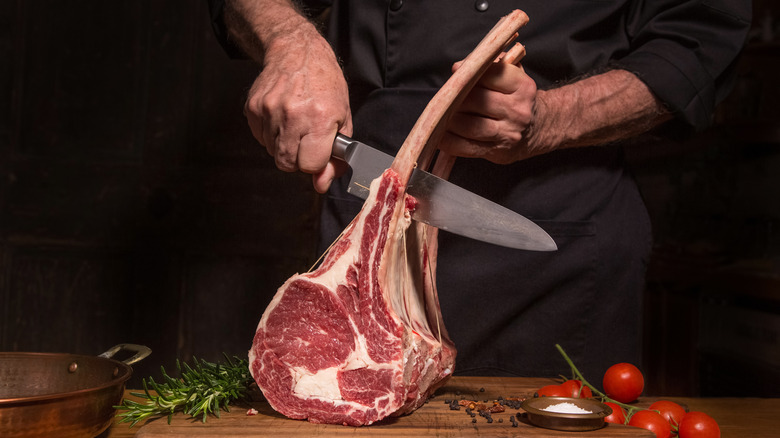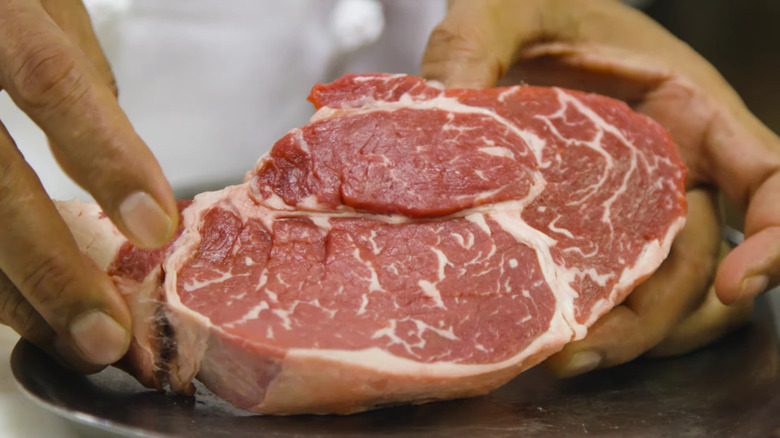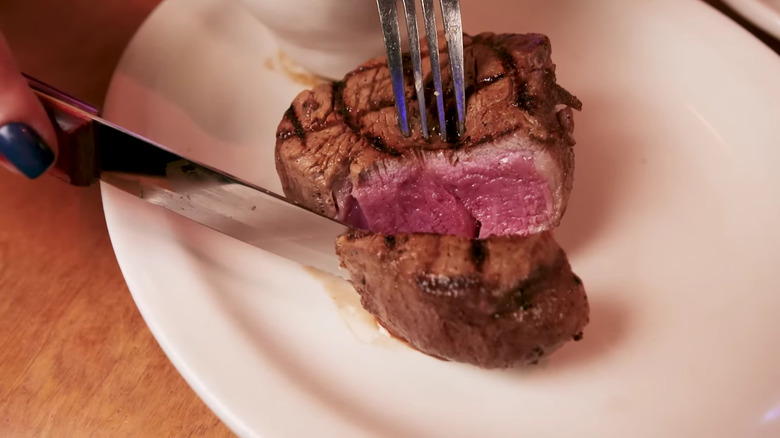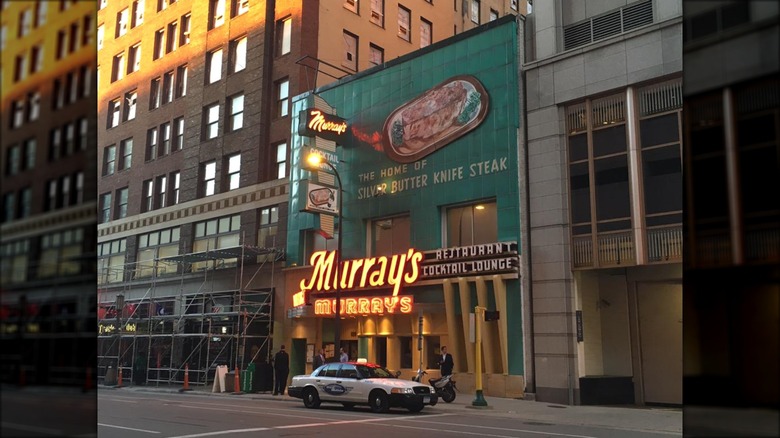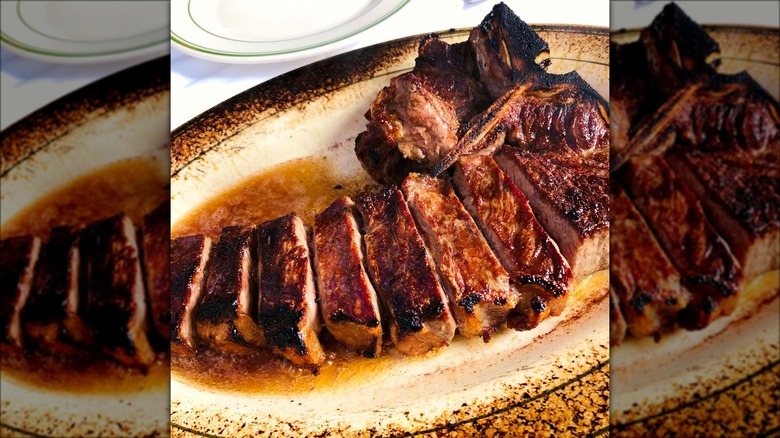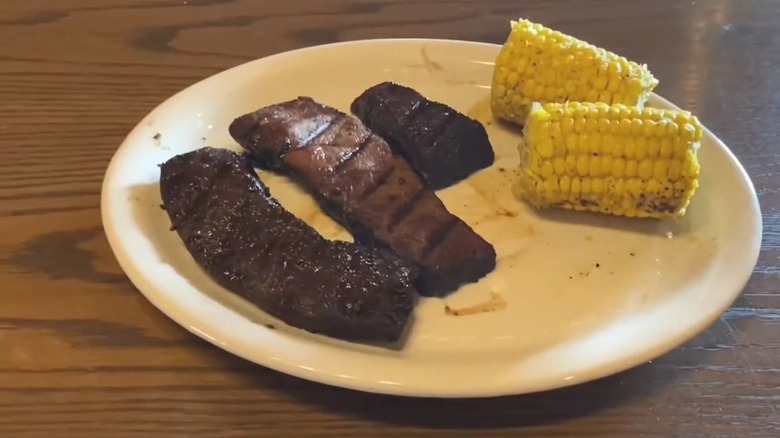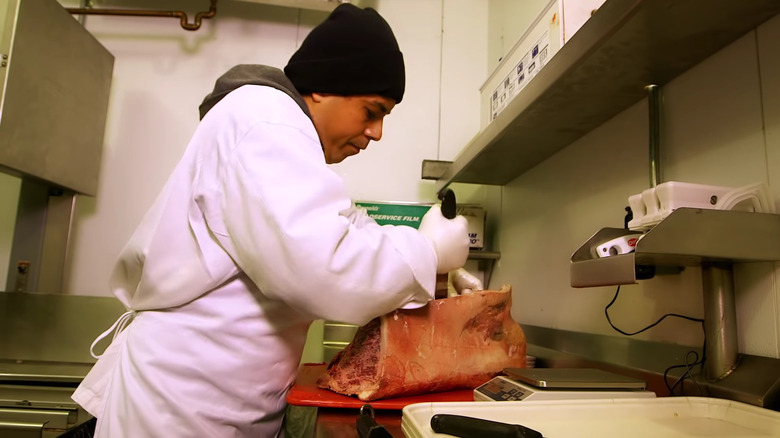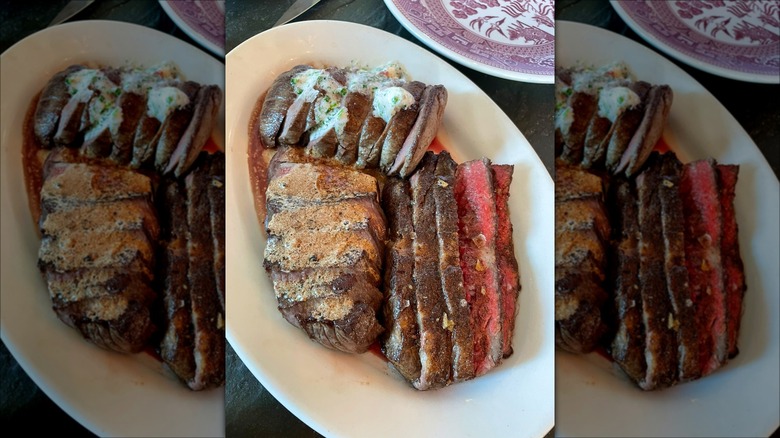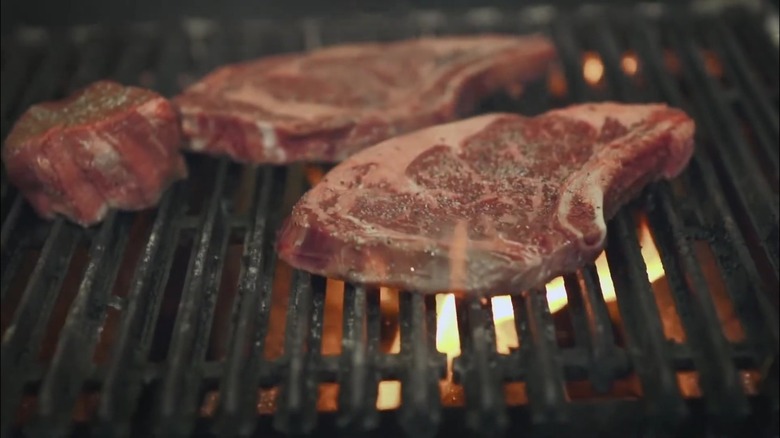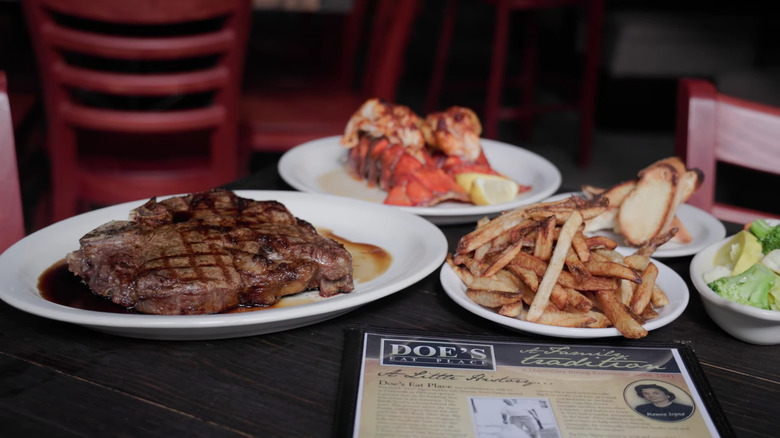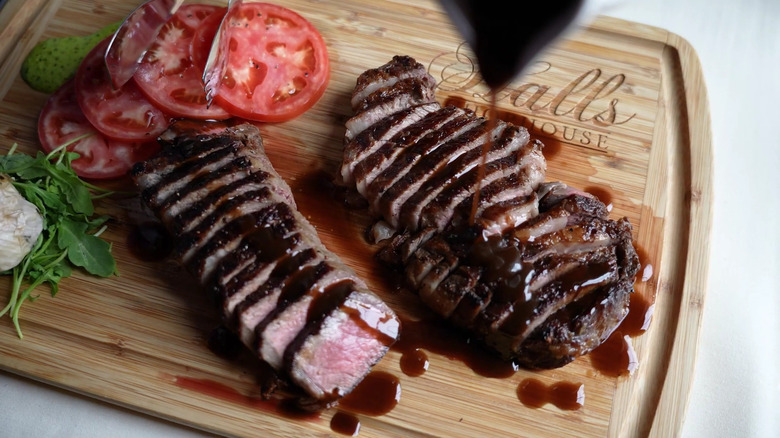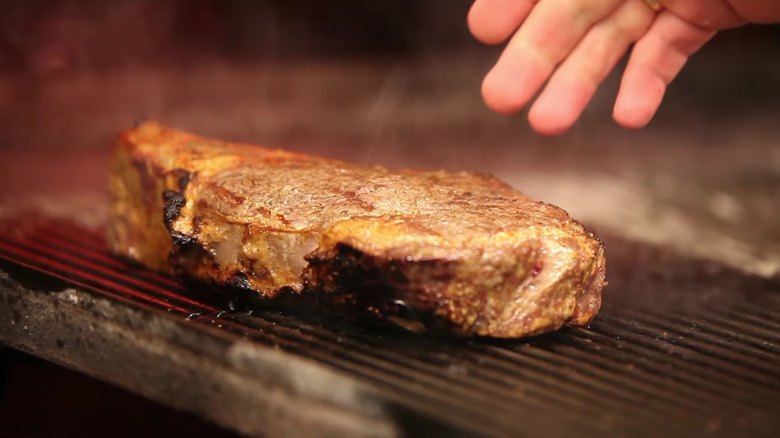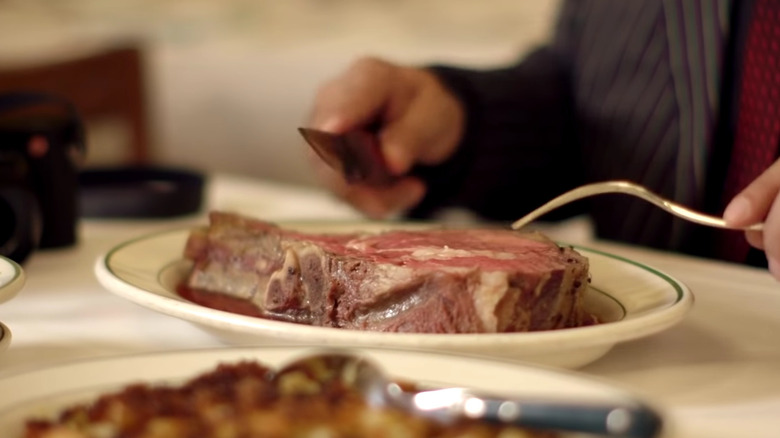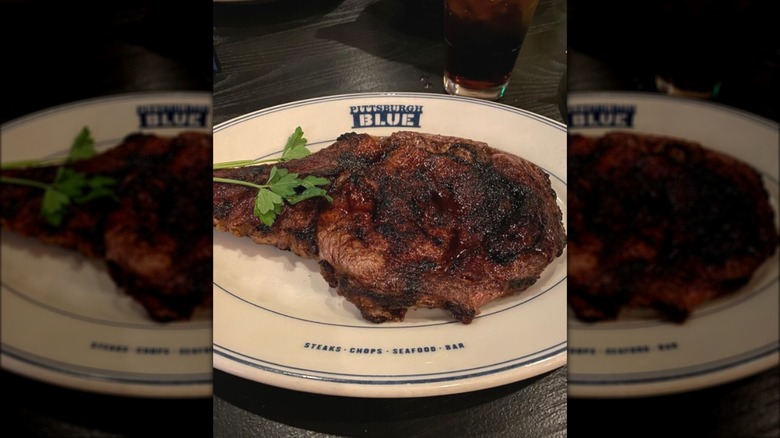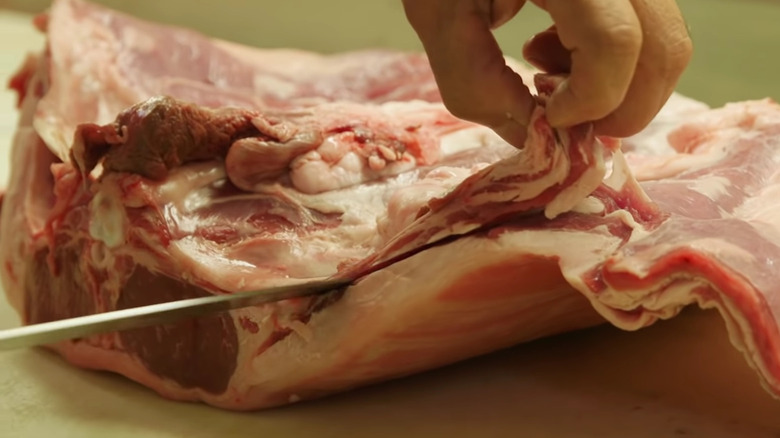The Steakhouses You Should Visit If You Want To Order A Hand-Cut Steak
Steakhouses are a much-loved institution. For decades, these establishments have satiated the public's desire for red meat by serving a variety of cuts in a refined, plush setting. Service like this has seen steakhouses maintain, and in some instances increase, their popularity. Some estimates, including one produced by Smartscrapers, place the total number of American steakhouses at over 15,000 .
By their nature, steakhouses have limited space for chefs and owners to innovate. However, this hasn't stopped them from searching for a way to set themselves apart. One method is to focus on the quality of the meat itself; sourcing USDA Prime beef and utilizing extensive dry aging periods are two particularly popular means. These methods, however, are victims of their own success, with numerous restaurants now adopting them. As a result, several steak houses have begun to seek alternative methods, such as serving hand-cut steaks.
Hand-cut steaks are cut from large sections of cow carcasses, known as primal or sub-primal, by trained meat cutters. This stands in contrast to the common practice of steakhouses ordering mechanically-cut steaks directly from suppliers. Aside from being an artisanal practice, taking the time to hand-cut steaks is an indication that steakhouses are going the extra mile in other aspects of preparation, from properly aging the steaks to sourcing meat from the best suppliers. As a result, more steakhouses are adopting this practice, including both chains and independents. We're here to take a look at the very best.
Bern's Steakhouse
Bern's Steakhouse is one of the most popular steakhouses in the United States. The restaurant's huge and impressive wine menu is often cited as the reason for this. However, Bern's is also celebrated for its steaks, all of which are hand-cut to order by the restaurant's butchers. These individuals produce a range of classic cuts in various sizes; both châteaubriand and filet mignon are available in three different weights. Despite these extensive offerings, Bern's encourages patrons to request any size or cut of steak they desire. The kitchen does its best to meet any demand.
The majority of beef served at Bern's Steakhouse is classified as USDA Prime, the highest grade of beef certified by the U.S. Department of Agriculture. This beef's flavor is developed through an in-house dry aging process that lasts between five to eight weeks. During this time, the beef loses moisture and has its connective tissue broken down by enzymes. Both of these processes intensify the meat's natural flavor. Finally, all steaks are cooked over natural hardwood lump charcoal, giving them a crisp, browned exterior. For these reasons, Bern's Steakhouse is one of the best places in America to experience exquisite hand-cut steaks.
Texas Roadhouse
The term "hand-cut steaks" has a sense of exclusivity about it. Yet you needn't visit an eye-wateringly expensive steakhouse to sample them. Texas Roadhouse proves this by serving steaks hand-cut by the company's in-house meat cutters at exceptionally low prices. While a hand-cut steak from, say, Bern's will set you back at least $50, many of those sold at Texas Roadhouse are priced under $20. Admittedly, Texas Roadhouse's steaks are not as high quality as those served by other restaurants in this article. The chain only serves USDA Choice, which has less marbling than USDA Prime beef. That being said, the steaks are still well cut and hugely enjoyable.
Texas Roadhouse takes great pride in the skill of its meat cutters and even holds an annual competition known as the Texas Roadhouse Meat Cutter Competition. In this competition, meat cutters employed in Texas Roadhouses across the country convene and compete with the goal of finding out who is the company's best meat cutter. The employee who's eventually named meat cutter of the year wins $25,000. Those who don't take the top prize receive feedback on their cuts, ensuring that the meat that reaches customers' plates improves year-on-year.
Murray's
Murray's is a steakhouse in Minneapolis which has been open since 1946. This institution has its fair share of enticing menu items, but guests will struggle to look past Murray's range of steaks. Each of the eight steaks listed on the menu is cut and prepped in-house. Veteran meat-cutter Boyd Freeman described the process in an interview with Eater Twin Cities: "We bring our meat in after being aged 30 days, and every piece of meat that comes through the door I inspect or the chef does [...] We look at consistency in size — the eye size, the marbling, make sure the age on it. It comes in strips, so I precision cut them and trim them up to our specs."
Cutting the steaks in-house allows Murray's to serve the Silver Butter Knife Steak, an unusually large strip sirloin that weighs an impressive 28 ounces. This steak has become Murray's iconic offering with customers traveling from across the country to try it. Not only does this hand-cut steak bring in business, it also forms a part of the steakhouse's character, demonstrating the immense benefit that serving unique, hand-cut steaks can bring to a business.
Wolfgang's Steakhouse
Founded by Wolfgang Zwiener, one-time head waiter at Peter Luger Steak House, Wolfgang's Steakhouse now boasts over 20 establishments. All of them serve USDA Prime black angus beef that is broken down into steaks by a team of in-house butchers. These skilled individuals turn out a variety of cuts, but few are as widely celebrated as the Porterhouse For Two Or More. This large cut has become the brand's signature.
As with many steakhouses on this list, Wolfgang's believes in keeping it simple, allowing the quality of the beef and the skill of the staff to be on full display. This is evidenced throughout the steak's preparation, as co-founder Peter Zwiener highlighted to Esquire: "It's all about finding the best beef ... we put it in our own aging room, keep it for an average of 28 days, sometimes it goes a little bit longer, and then we cut the beef to certain specifications."
Colton's Steak House and Grill
Colton's Steak House and Grill is a restaurant brand with locations across multiple American states including Arkansas, Mississippi, and Kentucky. USDA Choice steaks are served at all of these establishments and are hand-cut in-house every day. Notably, Colton's Steak House and Grill does not emulate the likes of Murray's by cutting left field steaks. Instead, these meat cutters produce a range of dependable and popular cuts including ribeye, filet mignon, and T-bone. Priced similarly to Texas Roadhouse, these steaks are much more affordable than the hand-cut steaks served by many other establishments featured in this article.
Colton's Steak House and Grill also sets itself apart through the fuel it uses to power its grills. Instead of using charcoal, this brand opts for mesquite wood, which burns at extremely high temperatures, ensuring the brand's hand-cut steaks achieve a nice sear. The wood also imparts a strong smoky flavor that further elevates these hand-cut, USDA Choice steaks.
The Capital Grille
The Capital Grille is a chain of high-end steakhouses with numerous establishments located around the United States and one a piece in Mexico and Costa Rica. Each of these steakhouses takes pride in serving steaks that are hand-cut by an in-house butcher. Aside from being masterfully cut, all these steaks are also dry aged for around three weeks. To further amplify their flavor, The Capital Grille's steaks are often served alongside intense sauces and decadent crusts. These include a cherry cabernet reduction and a porcini mushroom crust.
With so many locations dotted around the country, many Americans now associate The Capital Grille with good, dependable steaks. The company has sought to take advantage of this by launching The Capital Butcher, an online service wherein customers can order The Capital Grille's dry aged, hand-cut steaks for home cooking. Customers have the option of ordering single steaks or a Steak Grille Box which contains a selection of four steaks. Options include a bone-in New York strip and both 8 ounce and 10 ounce portions of filet mignon. Orders from The Capital Butcher are pick-up only.
Bateau
The vast majority of steakhouse butchers and meat cutters portion steaks from strips and sub-primals. As steakhouses serve numerous servings of popular cuts like filet mignon in a single night, these restaurants often order in multiple tenderloins to meet demand. Bateau does things differently, ordering in a whole carcass and one to three supplemental slabs of beef per week. They proceed to butcher them and subsequently sell every single cut.
This method means Bateau sells cuts many diners have never heard of, let alone tried. What's more, the menu is always changing as certain cuts sell out and others become available. Such an approach is challenging for both staff and diners alike, both of whom are used to popular cuts being readily available. However, thanks to the diligent staff, Bateau has worked out ways of making even the smallest, toughest cuts both tender and flavorful.
Bateau takes sourcing just as seriously as preparation; all cows are heritage breeds that have been grass-fed and grass-finished. This not only influences the flavor of the meat but also limits the animal's environmental impact, as detailed by The New York Times, and allows them to contribute to regenerative farming practices. The end result is a steakhouse that takes the ethos behind hand-cut steaks to new heights.
B&B Butchers & Restaurant
So far, we've focused on the impact in-house butchers and meat cutters can have on beef steaks. Yet these individual's talents need not be limited to beef alone. B&B Butchers & Restaurant highlights this perfectly, with some of its most popular meat dishes arising as a direct consequence of the in-house butchering team's work on pigs.
In an interview with Eater Houston, B&B owner Benjamin Berg highlighted that the restaurant's selection of bacon appetizers were among its most popular items. The butchering team played a direct role in this success as Berg explained: "We cut it way thicker than anyone else does. It's smoked and we pepper it properly, but it's more about the cut. Even though it's bacon, it almost has that pork belly feel to it. My chef and I couldn't believe how much the bacon was being ordered."
Thick cut bacon is just one of the 22 cuts the B&B butcher team produces for the steakhouse. This selection also includes cuts of USDA Prime and A5 certified Kobe beef. All of these steaks are dry aged in a meat cellar lined with pink Himalayan salt blocks. These blocks help dry the meat out. By the end of the aging process, most cuts have lost around 40% of their weight. Further cuts and other products, including sausages, are available in B&B's adjoining butcher shop.
Doe's Eat Place
Doe's Eat Place is a chain of steakhouses that was founded during 1941 in Greenville, Mississippi. For decades, this restaurant, and the others which have opened under the Doe's Eat Place name, have served hand-cut steaks butchered from whole beef loins. Every piece of beef is aged for a minimum of three weeks, resulting in robustly flavored meat.
The meat cutters that work in Doe's Eat Place play a huge role in the restaurant chain's success by producing the brand's iconic steaks. All steaks are cut to nearly two inches thick and are deliberately oversized; the brand's porterhouse, T-bone, and ribeye steaks all weigh at least two pounds. These steaks, which are designed to be shared family-style, dominate the menu and have become the brand's main attraction. Only one steak, a filet mignon, is available in smaller sizes. It can be ordered in 8 or 10 ounce portions, making it much more suitable for those dining alone.
Halls Chophouse
The first Halls Chophouse opened in Charleston in 2009. Since then, four more have opened. All of these establishments source their meat from Allen Brothers, one the most renowned meat suppliers in the United States. By using Allen Brothers, Halls Chophouse outsources the meat selection, aging, and hand-cutting processes. This is not to say the steaks are any worse than those trimmed, cut, and aged in-house. In fact, some would argue that Allen Brothers does a much better job than many steakhouses, thanks to the company's 100 years' worth of experience and attention to detail and quality.
Despite Allen Brothers cutting steaks to proportions dictated by Halls Chophouse, the steakhouse is limited in its ability to meet customers' desire for specialist cuts and weights. That being said, the restaurant does boast an extensive menu of both wet and dry aged steaks including tomahawk steaks, porterhouses, and even a bison filet. All of this suggests that just about every customer will have their desires catered to.
Chicago Cut Steakhouse
Chicago Cut Steakhouse is a formal and eye-wateringly expensive restaurant located on the north bank of the Chicago River. Here, USDA Prime beef is butchered on site and portioned into cuts including a 32 ounce bone-in prime rib and a 24 ounce porterhouse. Both steaks are priced just under $100 and are dry aged on site for at least 35 days.
The steakhouse sells all of the usual accompaniments including steak sauce and blue cheese fondue. More uniquely, Chicago Cut Steakhouse also offers customers the opportunity to order their steak black and blue. Customers who order their steak like this should expect it to arrive charred on the outside and almost raw on the inside.
While not to the taste of some customers, the contrast between the well-done exterior and raw interior demonstrates the full range of Chicago Cut Steakhouse's hand-cut, USDA Prime steaks. Of course, more regular cooking preferences, spanning from rare to well-done, are also accomodated.
Smith & Wollensky
Smith & Wollensky is a well-known brand of steakhouses with eight locations around the United States and two abroad. This manageable size means that Smith & Wollensky can source its meat directly from smaller, sustainably-minded suppliers, including Double R Ranch. This not only ensures that the steakhouses are receiving high quality beef, but also that its beef is fully traceable. These suppliers provide the restaurant with a dependable source of well-marbled, grain-fed, USDA Prime beef. Smith & Wollensky further develops flavor by dry aging all cuts in-house for at least 28 days.
All of the meat that's delivered to Smith & Wollensky is checked, cut, and aged by a team of in-house butchers. Danny Kissane, a veteran butcher at Smith & Wollensky, explained the process in an interview with Eater, remarking, "We butcher anywhere from a ton of beef to three tons of beef a day here ... There's all different cuts of meat. Most of it's all primal meats, center cut meats, loin meat, shells, filets, rib roasts."
Aside from USDA Prime steaks, the team at Smith & Wollensky also butchers and serves American wagyu sourced from Snake River Farms. The standout of these steaks is a hugely impressive wagyu porterhouse for two that weighs at least 38 pounds. Priced at $260, this steak is the most expensive — and eye-catching — item on the menu.
Pittsburgh Blue Steakhouse
Pittsburgh Blue Steakhouse serves hand-cut Midwestern beef at all three of its restaurants. These cattle are corn-fed to maximize marbling. Upon arrival at the restaurant, the meat is cut and trimmed by master butchers before being cooked and served to customers.
The restaurant specializes in filet mignon with an impressive seven different variations available. These include a horseradish-crusted filet and one served Oscar-style, topped with a crab cake, asparagus and béarnaise sauce. The master butchers also prepare a range of other traditional steaks including sirloin, ribeye, and bone-in tenderloin. Finally, three different sizes of salt-crusted prime rib are available: 10 ounce, 16 ounce, and 24 ounce. All three cuts are aged for 21 days.
Guests can accompany their hand-cut steaks with a wide array of beverages. The use of Coravin preservation systems means that expensive wines, including Opus One, can be enjoyed by the glass, providing the perfect accompaniment to the punchy steaks. The restaurant brand also stocks a very impressive range of whiskey.
Keens Steakhouse
Keens Steakhouse opened in 1885 and retains an old-fashioned charm. Yet the steakhouse's menu does not feel dated. This is thanks to the restaurant's attention to detail; all meat is carefully sourced and both butchered and dry aged in-house.
In terms of beef, only USDA Prime is served. However, Keens is one of those rare steakhouses where beef is not the main attraction. Instead, patrons come from all over the country to sample the restaurant's famous mutton chop, a succulent, two inch thick, 26 ounce slab of 12 month old lamb. This is not to say that the beef is disappointing. To the contrary, all of the approximately 6,000 pounds of USDA Prime beef that enters Keens Steakhouse's kitchen is exceptional, having been personally checked by executive chef Bill Rodgers. With this meat, Keens Steakhouse hand-cuts and sells an exciting variety of steaks, including a New York sirloin and an enormous porterhouse designed to be split between three.
